Last updated: August 4, 2017
The issues documented in this article have been reported after installing the recent updates listed below:
If you’re a Microsoft 365 customer, install the latest updates that are available today to resolve the issues. Go to File > Office Account > Update Options > Update Now.
ISSUE
Last updated: July 27, 2017
This issue affects Outlook 2007 and Outlook 2010.
When you open an attachment in an email, contact, or task formatted as Rich Text you get the following error:
"The program used to create this object is Outlook. That program is either not installed on your computer or it is not responding. To edit this object, install Outlook or ensure that any dialog boxes in Outlook are closed".

You may also see:
“This item contains attachments that are potentially unsafe. You may not be able to view these attachments after you close them”.
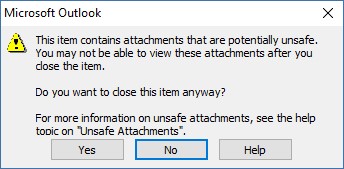
Status: Fixed
Install the updates below to fix the issue for Outlook 2007 and Outlook 2010:
Update for Outlook 2007: July 27, 2017
Update for Outlook 2010: July 27, 2017
Workaround
-
Forward the email to yourself and then open the attachments from the forwarded email.
-
Change the email format to HTML, or Text format.
-
Save the attachments to your computer, using one of the following methods, then open them from the saved location:
-
Drag and drop the attachments to your desktop.
-
Go to File > Save Attachments.
-
Copy and paste the attachment to your computer.
-
ISSUE
Last updated: July 27, 2017
This issue affects Outlook 2007, Outlook 2010, Outlook 2013, and Outlook 2016.
When opening an attachment that includes consecutive periods (...), or an exclamation point (!), the files are blocked and you receive an Opening Mail Attachment warning.

Or if an email message includes an attached email message, and the attached email message's subject line ends with an unsafe file name extension as listed in the Blocked attachments in Outlook, the email attachment will be blocked for recipients.
STATUS: Fixed
If you’re an Microsoft 365 customer, install the latest updates to resolve the issues. Go to File > Office Account > Update Options > Update Now.
For Outlook 2007, Outlook 2010, Outlook 2013 and Outlook 2016, install the updates below to fix the issue:
Update for Outlook 2007: July 27, 2017
Update for Outlook 2010: July 27, 2017
Update for Outlook 2013: July 27, 2017
Update for Outlook 2016: July 27, 2017
Workaround
If you get the Opening Mail Attachment warning, and you're sure the attachment was sent from a trusted source, proceed to Open or Save the attachment.
If the file is blocked because of a potentially unsafe file extension, ask the sender to save the email message to their computer and rename its subject line so that it does not end with an unsafe file name extension. Then, attach it to the email message and resend.
ISSUE
Last updated: July 27, 2017
This issue affects Outlook 2013 and Outlook 2016.
If you set ShowLevel1Attach to allow Outlook to display Level 1 attachments, you may see the error: “One or more objects in this file have been disabled due to your policy settings”.
Warning: Typically, Level 1 attachments are blocked. If you have enabled this policy, users can see Level 1 attachments in Outlook. If you use any of the workarounds to open the files, please make sure they are safe to open. See: Information for administrators about e-mail security settings in Outlook 2007.
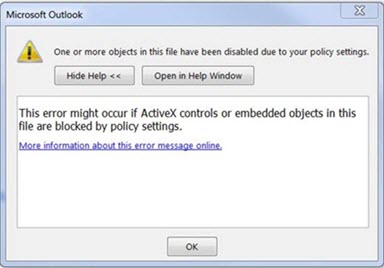
If you set ShowLevel1Attach to allow Outlook to display Level 1 attachments, and you send an email with an attachment you may see this message: "This item contains attachments that are potentially unsafe. Recipients using Microsoft Outlook may not be able to open these attachments."
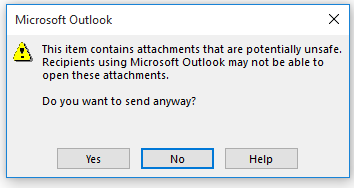
STATUS: Fixed
If you’re an Microsoft 365 customer, install the latest updates to resolve the issue. Go to File > Office Account > Update Options > Update Now.
For Outlook 2013 and Outlook 2016, install the updates below to resolve the issue:
Update for Outlook 2013: July 27, 2017
Update for Outlook 2016: July 27, 2017
Workaround:
-
Change the email format to HTML, or Text format.
-
Save the attachments to your computer, using one of the following methods, then open them from the saved location:
-
Drag and drop the attachments to your desktop.
-
Go to File > Save Attachments.
-
Copy and paste the attachment to your computer.
-
ISSUE
Last updated: Sep 17, 2017
Note: Please also see this article for an update on this issue: Custom form script is now disabled by default.
This issue affects Outlook 2007, Outlook 2010, Outlook 2013, and Outlook 2016.
When you use a custom form that you have created for Outlook, you see the following two symptoms:
-
VBScript does not run.
-
You get a malicious code warning:
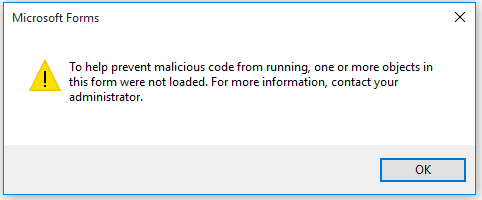
STATUS
If you’re a Microsoft 365 customer, the fix is now available to Insider Fast audience.
For other channels, an update is scheduled for mid-September, in versions 16.0.8418.5703 and later. We will update this page when the fix is released.
Issue is fixed for all MSI versions. For Outlook 2007, Outlook 2010, Outlook 2013 and Outlook 2016, install the updates below to fix the issue:
Update for Outlook 2007: July 27, 2017
Update for Outlook 2010: July 27, 2017
ISSUE
Last updated: August 3, 2017
This issue affects all Outlook versions on Windows 7, Windows 8, Windows 10.
When searching in Outlook, you get this error: “Something went wrong and your search couldn’t be completed.”, or "Search results may be incomplete because items are still being indexed".

And you'll see this Event Log warning:

STATUS: FIXED
Windows has released fixes via Windows Updates to address a reliability issue in Windows Search. Below are the relevant KB updates for each version:
Note: The fix for this issue has been released on June 27, 2017. If you implemented the workaround to disable Windows Desktop Search Service, you can now set the PreventIndexingOutlook registry key to DWORD: 0 to go back to using Windows Search.
WORKAROUND
If the issue is not resolved after installing the updates, please use the workaround below:
-
If search is not working for Exchange accounts, delete the OST files which will cause a re-sync and re-index of the account:
-
OST files are typically stored at C:\Users\<your username>\AppData\Local\Microsoft\Outlook.
-
To find the name and location of the OST file, click File, Account Settings, Account Settings, Data Files. Locate the correct email address, click on the name, and click Open File Location.
-
Before you can delete the OST file, you need to close Outlook so the process will release the file.
-
After deleting the file, restart Outlook and let the email sync again.
-
-
Another workaround is to Create a new Outlook profile, and add your accounts to the new profile. We recommend keeping the old profile until you know you have moved over any local data or PST files.
Until you can install the Windows Update fix release, you can set a registry key that will cause Outlook to stop using the local Windows Search service. When this registry key is set, Outlook will use its own built-in search engine. The built-in search will display the message below to indicate it is not using the Windows Search service.

Disable Windows Desktop Search Service for Outlook:
Note: The following steps show you how to modify the registry. However, serious problems might occur if you modify the registry incorrectly. Please make sure that you follow these steps carefully. For added protection, back up the registry before you modify it. Then, you can restore the registry if a problem occurs. For more information about how to back up and restore the registry, see this article.
-
Open Registry Editor.
-
Go to: Computer\HKEY_LOCAL_MACHINE\SOFTWARE\Policies\Microsoft\Windows\Windows Search
-
PreventIndexingOutlook
-
Set DWORD: 1
Detailed Instructions:
-
Click Start, click Run, type regedit in the Open box, and then click OK.
-
Locate and then click the following subkey in the registry:
HKEY_LOCAL_MACHINE\SOFTWARE\Policies\Microsoft\Windows -
On the Edit menu, point to New, and then click New Key and name the key Windows Search.
-
Click on the new key Windows Search.
-
On the Edit menu, point to New, and then click DWORD Value.
-
Type PreventIndexingOutlook for the name of the DWORD, and then press Enter.
-
Right-click PreventIndexingOutlook, and then click Modify.
-
In the Value data box, type 1 to enable the registry entry, and then click OK.
-
Note to disable the PreventIndexingOutlook setting, type 0 (zero), and then click OK.
-
Exit Registry Editor, and then restart Outlook.
ISSUE
iCloud fails to load properly in Outlook 2007, Outlook 2010, Outlook 2013 and Outlook 2016.
When accessing Calendar, Contacts, or Tasks, you get the following error:
The set of folders cannot be opened. MAPI was unable to load the information service C:\PROGRA~2\COMMON~1\Apple\Internet Services\APLZOD.dll. Be sure the service is correctly installed and configured."

STATUS: WORKAROUND
The loading of unregistered MAPI services has been disabled by default to make Outlook more secure.
If you're using Outlook 2010, Outlook 2013 or Outlook 2016, uninstall and re-install iCloud to resolve this issue. For more information, see this page.
For Outlook 2007, use the workaround below:
Warning: This workaround may make your computer or your network more vulnerable to attack by malicious users or by malicious software such as viruses. Microsoft does not recommend this workaround but is providing this information so that you can choose to implement this workaround at your own discretion. Use this workaround at your own risk.
If you have trusted applications that depend on being loaded in this manner, you can re-enable those applications by setting the following registry key:
REG_DWORD HKEY_CURRENT_USER\Software\Microsoft\Office\12.0\Outlook\Security\AllowUnregisteredMapiServices
You can use the following registry subkey to apply the registry setting as a domain policy:
HKCU\Software\Policies\Microsoft\Office\12.0\Outlook\Security\AllowUnregisteredMapiServices
Value 0 (default): Block loading of unregistered MAPI services. This is the recommended setting to avoid unexpected execution of unknown code.
Value 1: Enable loading of unregistered MAPI services.
Important: The following steps show you how to modify the registry. However, serious problems might occur if you modify the registry incorrectly. Please make sure that you follow these steps carefully. For added protection, back up the registry before you modify it. Then, you can restore the registry if a problem occurs. For more information about how to back up and restore the registry, see this article.
To make these registry changes, follow these steps:
-
Click Start, click Run, type regedit in the Open box, and then click OK.
-
Locate and then click the following subkey in the registry:
HKCU\Software\Microsoft\Office\12.0\Outlook\Security\
-
On the Edit menu, point to New, and then click DWORD Value.
-
Type AllowUnregisteredMapiServices for the name of the DWORD, and then press Enter.
-
Right-click AllowUnregisteredMapiServices, and then click Modify.
-
In the Value data box, type 1 to enable the registry entry, and then click OK.
Note: To disable the AllowUnregisteredMapiServices setting, type 0 (zero), and then click OK.
-
Exit Registry Editor, and then restart the computer.
Vulnerability information (applies to all versions)
MAPI does not validate that a provider’s DLL that it is requested to load is registered correctly in MapiSVC.inf or even that it comes from the local machine. This can be exploited by creating a file together with an OLE object in such a way to cause MAPI to load a DLL from a network share when the OLE object is activated. This can allow arbitrary code execution to occur.
ISSUE
This issue affects all Outlook versions on Windows 7, Windows 8, Windows 10.
When you print a specific iframe or frame in a web page, the print output may be blank, or text is printed that resembles the following:

Note: A frame is a part of a web page or browser window that displays content independent of its container. A frame can load content independently.
This problem has also been observed in both Internet Explorer 11, and in applications that host the IE Web Browser Control.
STATUS: FIXED
This issue is fixed.
For Internet Explorer 9 and 10, please see this article to install the updates: A blank page or "404" error prints when you try to print a frame
For Internet Explorer 11, see:
Last updated: July 26, 2017
ISSUE
Some Web-based Outlook add-ins don't work in Outlook when using on premise Microsoft Exchange 2013.
This only applies to the MSI installations of Outlook 2016/Office 2016. Click-2-Run installations are not affected. The Office App add-in may show an Operation Failed error or seem to not respond to button presses or other UI choices.
Status: Investigating
We're investigating the issue and will update this page when a fix is available.
Last updated: November 29, 2017
ISSUE
Outlook crashes when you click File > Options, and you see the error below.
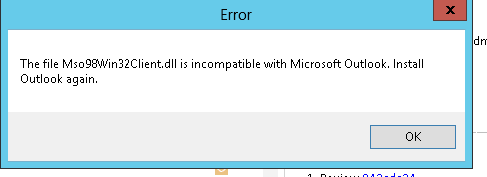
This issue only affects First Release for Deferred Channel Version 16.0.8201.2158.
Crash details:
Faulting application name: OUTLOOK.EXE, version: 16.0.8201.2158, time stamp: 0x5975d6bc
Faulting module name: KERNELBASE.dll, version: 6.1.7601.23807, time stamp: 0x5915fe14
Exception code: 0xc06d007f
Fault offset: 0x000000000001a06d
Faulting process id: 0x11fc
Faulting application start time: 0x01d307f0bc63afda
Faulting application path: C:\Program Files\Microsoft Office\root\Office16\OUTLOOK.EXE
Faulting module path: C:\windows\system32\KERNELBASE.dll
STATUS: FIXED
This issue is fixed in Semi-Annual Channel (formerly First Release for Deferred Channel) build 8201.2162 released in August 2017.
This issue is also fixed in Deferred Channel build 8201.2209 released in November 2017.
For more information about when builds are available for their respective channels, go to Update history for Microsoft 365.
Have a feature request?
|
|
If you have a feature you'd like to request, please send us your feedback to help us prioritize new features in future updates. See How do I give feedback on Microsoft Office for more information. |
Related Topics
Fixes or workarounds for recent issues in Outlook for Windows
Resolve Outlook for Windows issues with automated troubleshooting tools
Reconnect Outlook 2016 or Outlook 2013 to Outlook.com for uninterrupted email access












